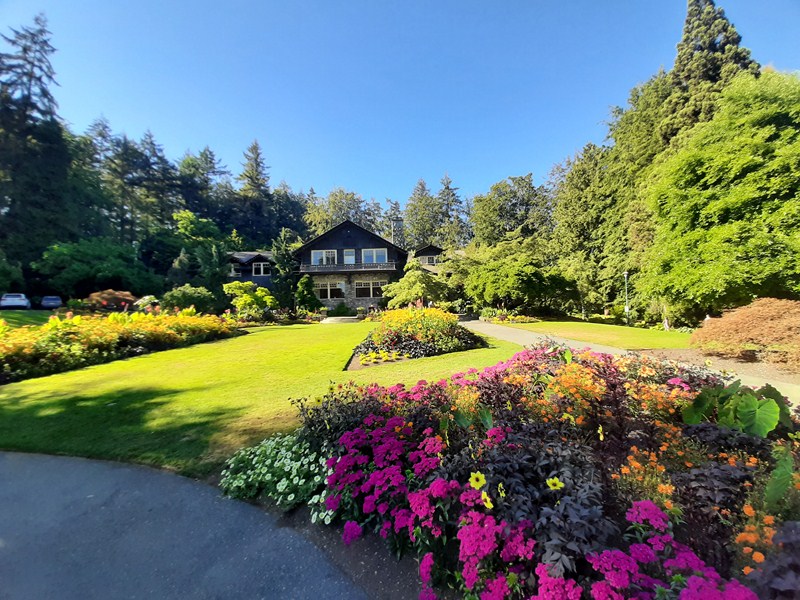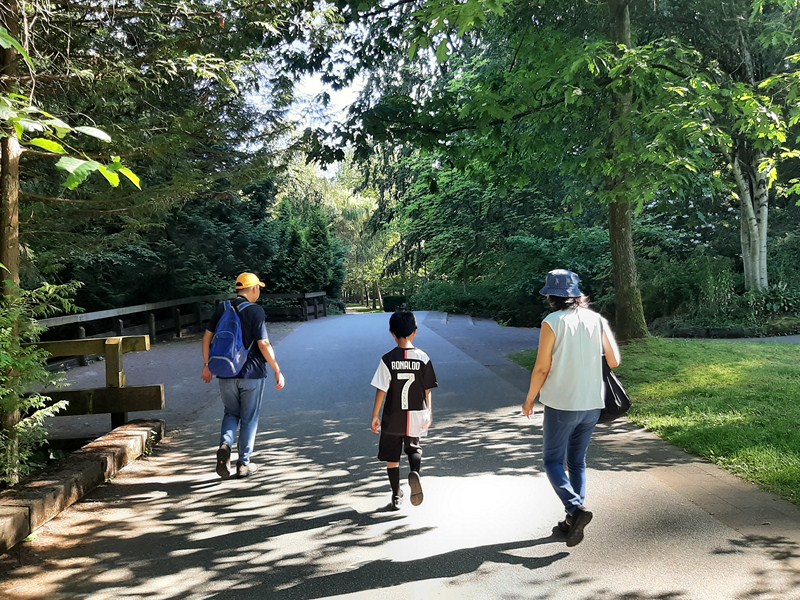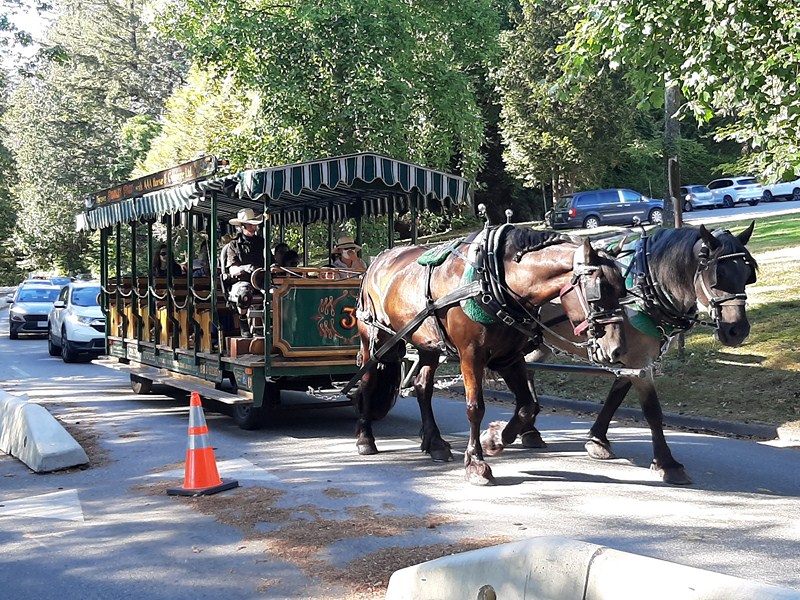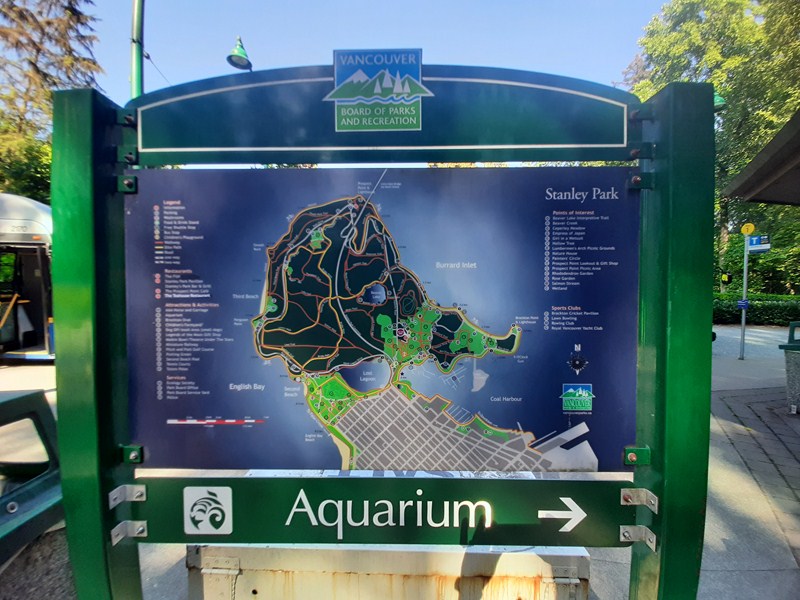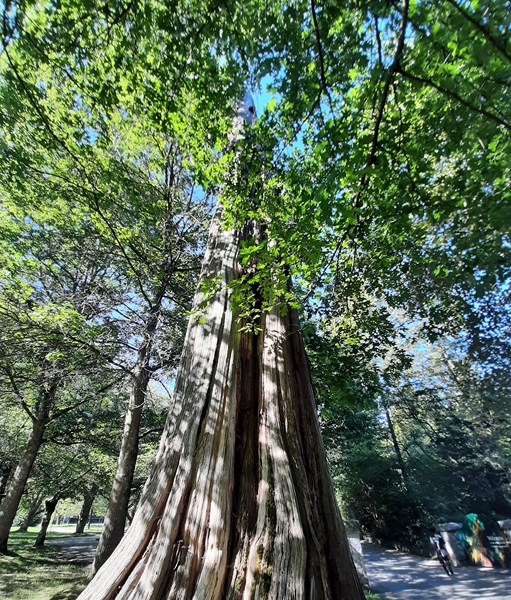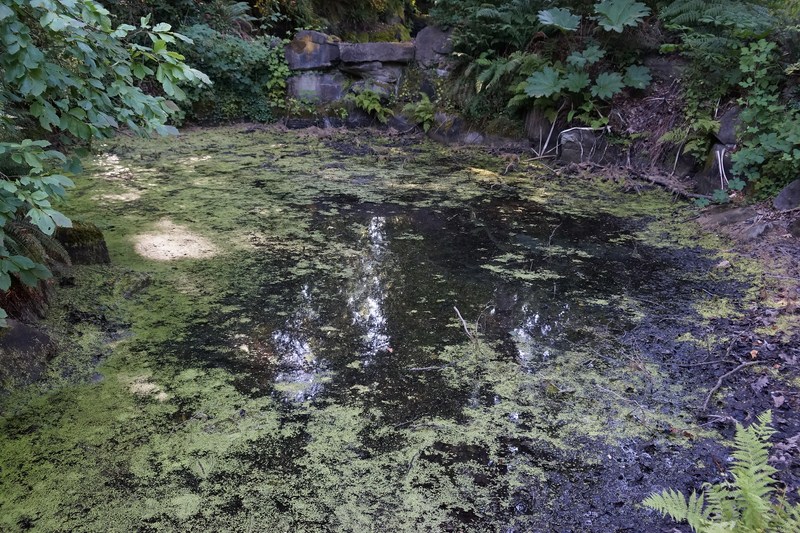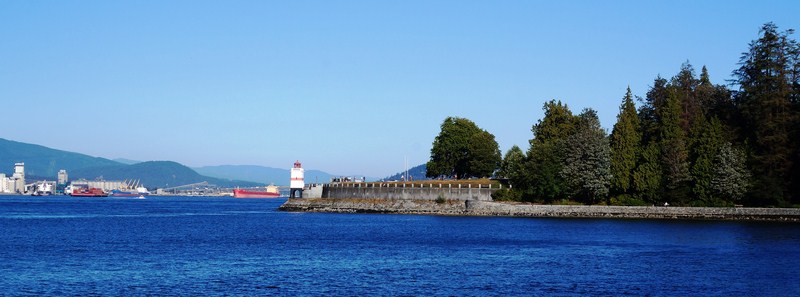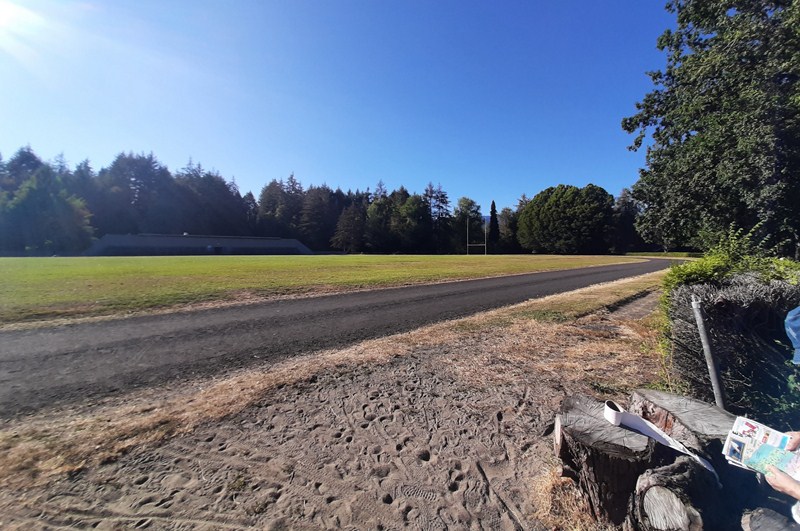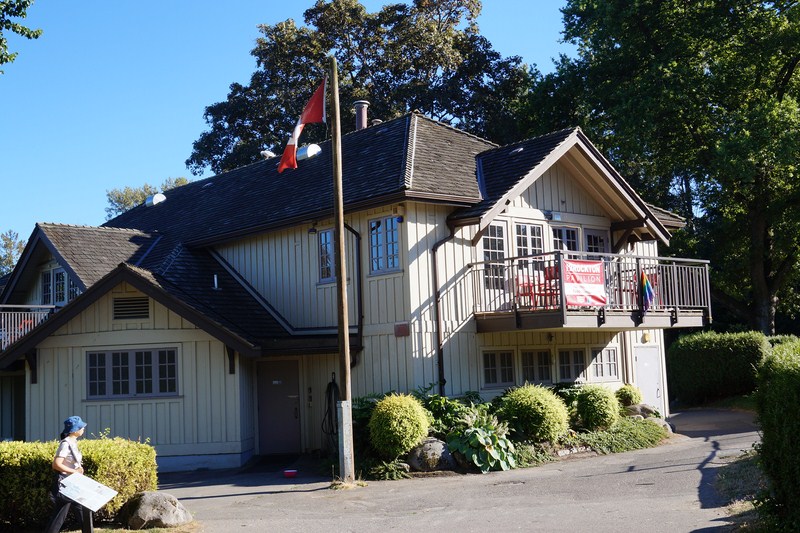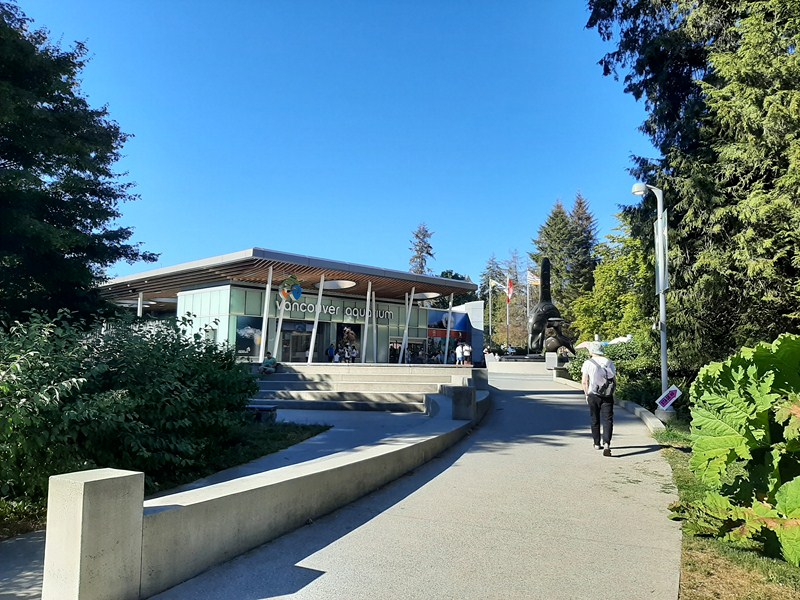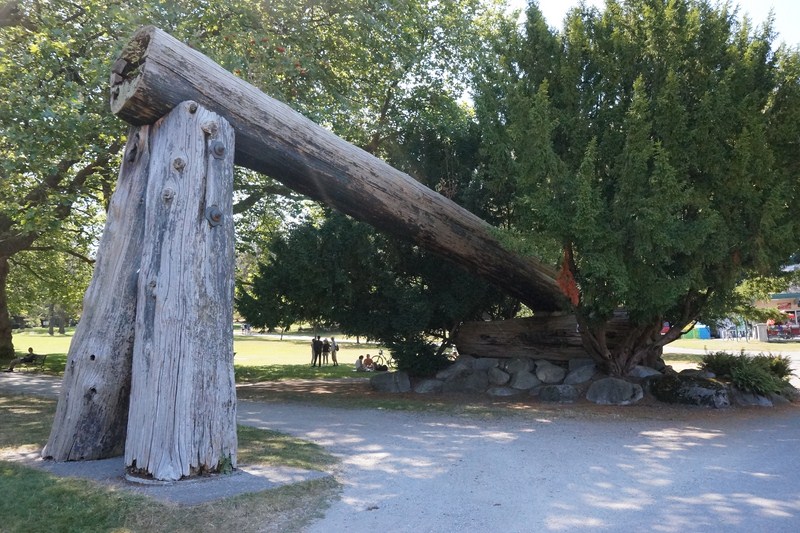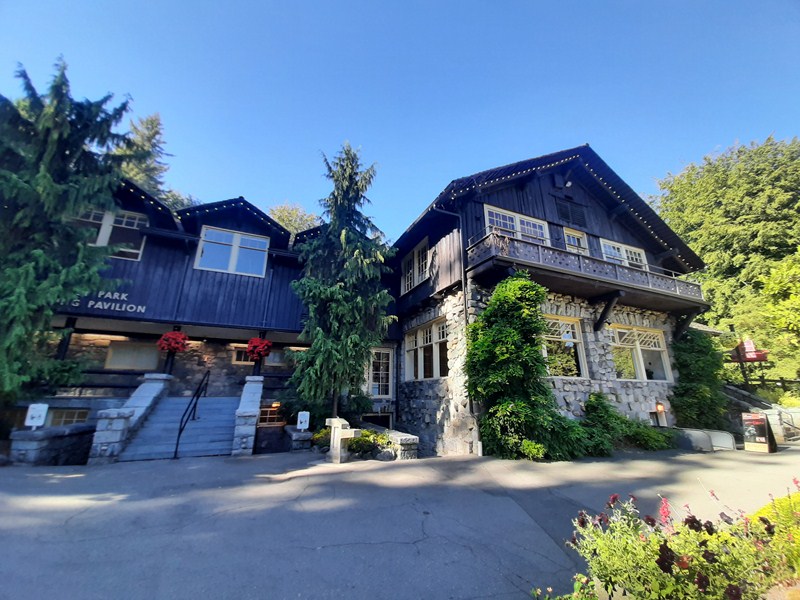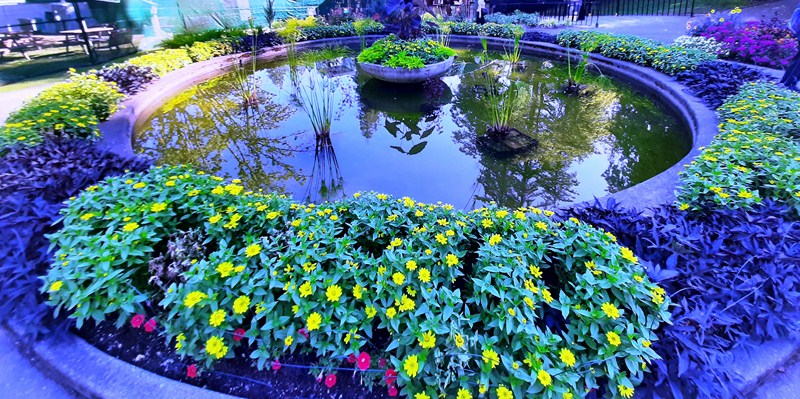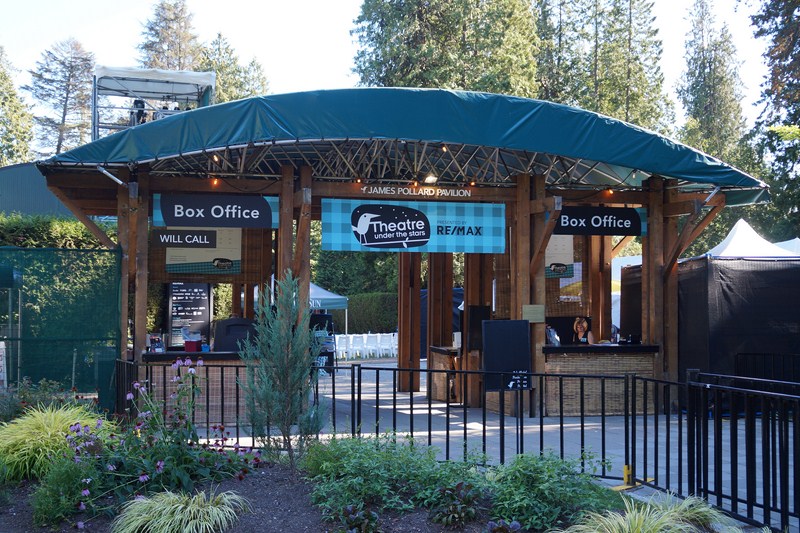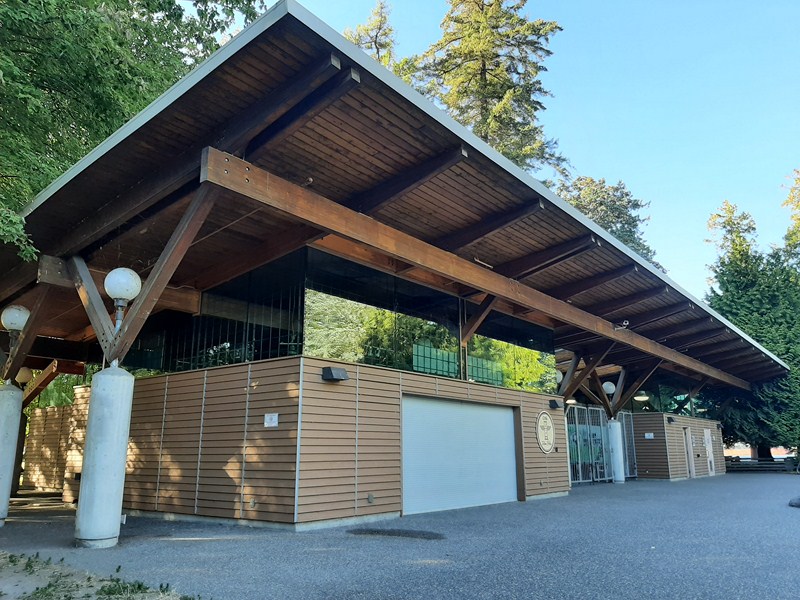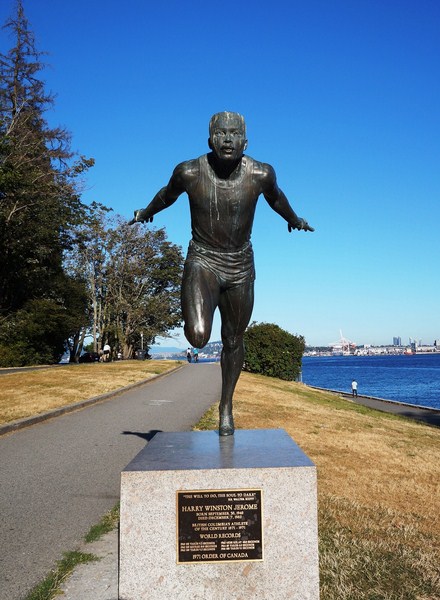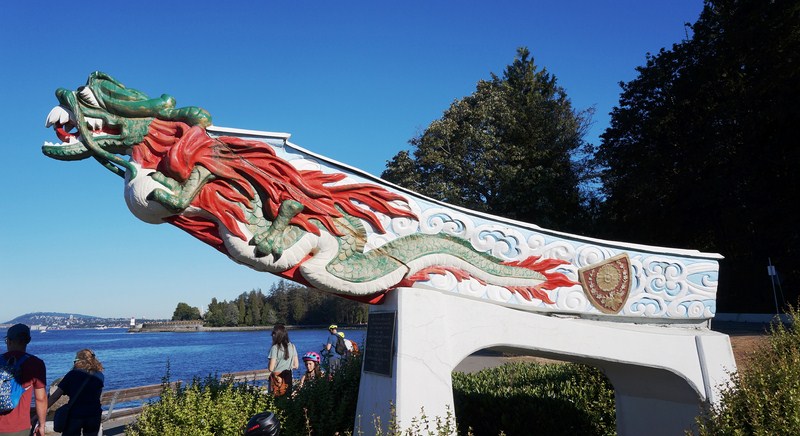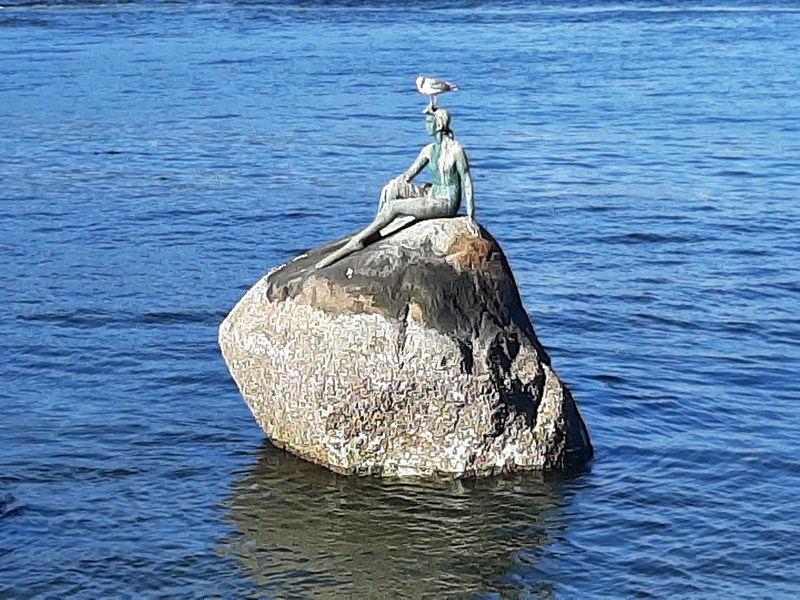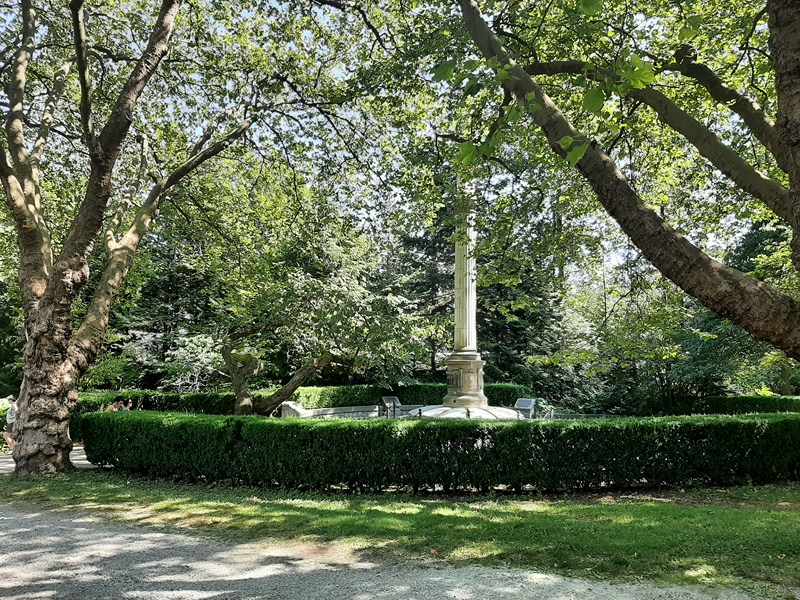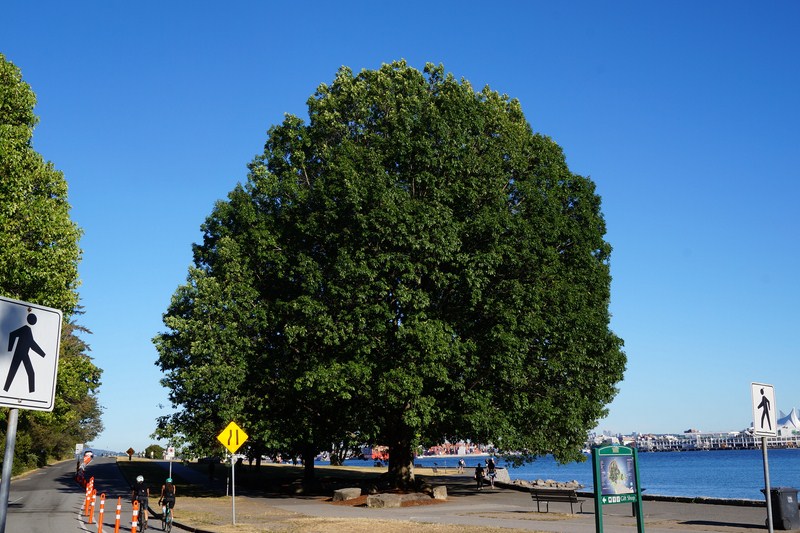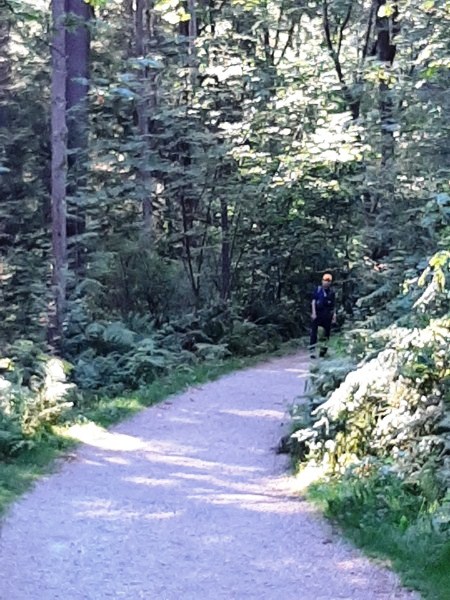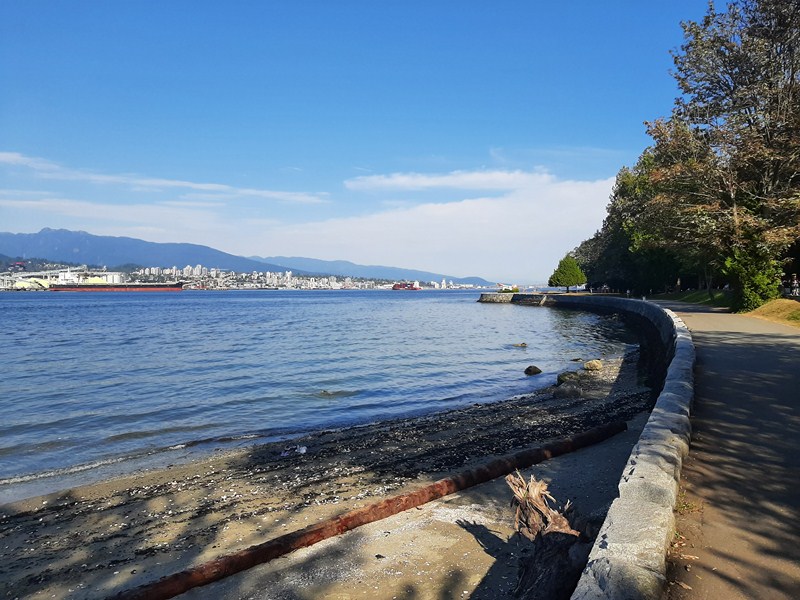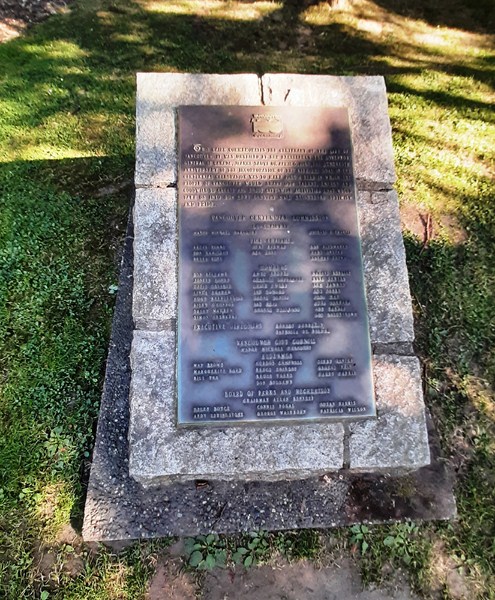The 405-hectare (1,001-acre) Stanley Park, a public park that makes up the northwestern half of Vancouver‘s Downtown Peninsula, is surrounded by waters of Burrard Inlet and English Bay. Bordering the neighborhoods of West End and Coal Harbour to its southeast, the park is connected to the North Shore via the Lions Gate Bridge. The park’s easternmost point is marked by the historic lighthouse on Brockton Point.
Stanley Park, while it is not the largest of its kind, is about one-fifth larger than New York City’s 340-hectare (840-acre) Central Park and almost half the size of London’s 960-hectare (2,360-acre) Richmond Park. The pak is best toured via horse-drawn carriages.
Originally known as Coal Peninsula, the land was originally used by Indigenous peoples for thousands of years before British Columbia was colonized by the British during the 1858 Fraser Canyon Gold Rush. One of the first areas to be explored in the city, it was, for many years after colonization, also be home to non-Indigenous settlers. The future park, with its abundant resources, was set aside for military fortifications to guard the entrance to Vancouver Harbor.
Much of Stanley Park remains as densely forested as it was in the late 1800s, with about a half million trees (cedar, fir, hemlock, etc.), some standing as tall as 76 m. (249 ft.) and hundreds of years old. Thousands of trees were lost (and many replanted) after three major windstorms that took place in the past 100 years (the last in 2006).
Here’s the historical timeline of Stanley Park:
- In 1886, when the city incorporated, the land was later turned into Vancouver’s first park and the Vancouver city council successfully sought a lease of the park which was granted for $1 per year.
- In September 1888, Lord Stanley, 16th Earl of Derby, a British politician who had recently been appointed Governor General, opened the park in his name.
- On June 18, 2014, based on reviews submitted, Stanley Park was named “top park in the entire world” by TripAdvisor.
Unlike other large urban parks, Stanley Park is not the creation of a landscape architect but, rather, the evolution of a forest and urban space over many years. Under the influence of then superintendent W.S. Rawlings, most of the manmade structures present in the park were built between 1911 and 1937. Additional attractions, such as a polar bear exhibit, the Vancouver Aquarium and a miniature train, were added in the post-war period.
Stanley Park is home to one of the largest urban colonies of great blue heron (classified as a species at risk in British Columbia) in North America. As far back as 1921, the birds have been documented nesting in various locations in Stanley Park. Since 2004, the Stanley Park Ecology Society has been monitoring the heronry in Stanley Park. In 2013, an estimated 156 young Pacific great blue herons were fledged from the colony. Since monitoring started in 2007, the highest number of great blue herons fledged in a year was 258 (in 2007) and the lowest number was in 2011 with just 99 of the birds fledged.
Stanley Park also has children’s playgrounds, sandy beaches, gardens, tennis courts, an 18-hole pitch and putt golf course, a seaside swimming pool, a water spray park, forest trails, lakes, and among many other attractions. It also has a large number of monuments, including statues, plaques, and gardens. Among these are the Japanese Canadian War Memorial, a cenotaph which has two rows of Japanese cherry (Prunus Shirotae ) trees, and statues of poet Robert Burns, Olympic runner Harry Jerome, and Girl in a Wetsuit.
Attractions found east of the causeway are:
- Nine O’Clock Gun
- Beaver Lake
- Lumberman’s Arch
- Vancouver Aquarium
- Stanley Park Pavilion
- Brockton Point and lighthouse
- Deadman’s Island (has no public access but can be seen from land near Brockton Point)
- HMCS Discovery Building (has no public access but can be seen from land near Brockton Point)
- Klahowya Village (open in summer, it is located behind the Stanley Park Pavilion)
- Rose Garden (developed in 1920-21, it is located south of the Stanley Park Pavilion)
- Rose Garden Cottage (built around the same time as the Rose Garden)
- Stables (located in the service yards of Stanley Park near the Rose Gardens at 605 Pipeline Road)
- Malkin Bowl
- Stanley Park Railway
- Rock Garden
- Vancouver Rowing Club(located by Coal Harbour entrance to the park, it was built in 1911)
- Totem poles at Brockton Point
The square lighthouse at Brockton Point , designed by Thomas Hayton Mawson, was built in 1914 to replace one built in 1890. Painted white with a red horizontal stripe, has a red lantern and an arched base with a walkway underneath.
The fields of Brockton Oval has, since 1891, been used for athletics (including an oval running track), track sports, rugby and cricket. Brockton Oval Clubhouse, also known as the Cricket & Rugby Pavilion, was built in 1927.
The Nine O’Clock Gun, an 1816 naval cannon located near Brockton Point, is the oldest manmade landmark in the park. Fired for first time in 1898, this tradition has continued for more than 100 years. Fired every day at 9 PM, the cannon was originally detonated with a stick of dynamite, but is now activated automatically with an electronic trigger.
Vancouver Aquarium, the largest in Canada and one of the five largest in North America, was opened in 1956. It houses a collection of marine life that includes dolphins, belugas, sea lions, harbour seals, and sea otters. In total, there are approximately 300 species of fish, 30,000 invertebrates, 56 species of amphibians and reptiles, and around 60 mammals and birds. The aquarium is also home to a 4D theatre.
Check out “Vancouver Aquarium”
Lumberman’s Arch, a children’s play area, water spray park and picnic area near the aquarium, the Lumberman’s Arch generally refers to a large clearing and picnic area on the park’s northeastern shore. There is also a Lumberman’s Arch landmark located across from the concession stand. The arch is a timber-and-stump structure erected in 1952 (a single log propped up by two others).
It replaced the original arch that was built by lumber workers in 1912 as organized labor’s contribution to the celebration of a visit by the Duke of Connaught. The 1912 arch was a copy of the Parthenon’s front, using whole trees for the columns and gable, and was originally located on the Duke’s carriage route at Homer and Pender Streets before it was moved to the park. It was torn down in 1947 after succumbing to rot.
Beaver Lake, nestled in the forest northwest of Lumberman’s Arch, this is a restful space nestled among the trees. Almost completely covered with water lilies (introduced for the Queen’s Jubilee in 1938) and home to beavers, fish, and water birds, as of 1997, the surface area of the lake was just short of 4 hectares (10 acres), but the lake is slowly shrinking in size. Beaver Creek – one of Vancouver’s few remaining free-flowing streams, joins Beaver Lake to the Pacific Ocean and is one of two streams in Vancouver where salmon still return to spawn each year.
Stanley Park Pavilion, located at Brockton Point, is now home to Stanley’s Park Bar & Grill. Built in 1911-12, it was designed by Otto Moberg. Architect Percy Underwood designed the addition, 1946–50, on the pavilion’s west side. It is close to the Vancouver Aquarium. The Rose Garden, located south of the Stanley Park Pavilion, was developed in 1920-21.
The Rock Garden, developed in 1911-1920 using stones excavated when the pavilion was built, encircles part of the Stanley Park Pavilion. The windstorm of 2006 revealed traces this long-forgotten rock garden which had once been one of the park’s star attractions and one of its largest man-made objects by area. Soon after its discovery, a section that encircles part of the Stanley Park Pavilion was restored (the garden had originally extended from Pipeline Road to Coal Harbour).
Stanley Park Railway, first started in 1947, is a diminutive steam train that pulls passenger cars on a circuit through the woods. In 1964, a new train and track opened. Located behind the Stanley Park Pavilion, the 508 mm. (20 in.) narrow-gauge, rideable miniature railway, with different seasonal themes, is a Vancouver tradition, especially for families with young children. The original railway featured a child-sized train. The current adult-sized railroad, opened in 1964 in an area leveled by Typhoon Freda, has an engine that is a replica of the first transcontinental passenger train to arrive in Vancouver in the 1880s.
Located in front of the Stanley Park Pavilion is Malkin Bowl, a “shell” stage modeled after the Hollywood Bowl in Los Angeles. It was built in 1934 by former mayor W.H. Malkin in honor of his late wife. On July 8, 1934, Malkin Bowl hosts its first concert, a free performance by the Vancouver Symphony that draws 15,000 people. It was rebuilt after a fire in 1982. In summer, the outdoor theatre (James Pollard Pavilion) features events by Theatre Under the Stars and Live Nation (with their Concerts in the Park series).
The totem poles at Brockton Point is the most visited tourist attraction in British Columbia. Many of the original poles were moved to museums in order to preserve them. Several replicas were commissioned or loaned to the park board between 1986 and 1992. Nearby is the Legends of the Moon Café.
Attractions found west of the causeway, in an area that includes Lost Lagoon and Prospect Point (a lookout at the highest point in the park located by the Lions Gate Bridge) include:
- Second Beach and pool (located on the south shore, past English Bay)
- Ceperley Meadow (a children’s play area and picnic area directly behind Second Beach)
- Third Beach (located on the southwest shore, past Second Beach, on sunny Tuesdays, a drum circle frequently breaks out at sunset)
- Ferguson Point (a lookout and picnic area located above Third Beach)
- Fish House Restaurant (located inland in a former sports pavilion, built in 1930, east of Second Beach)
- Hollow Tree (located on the side of the road heading up to Prospect Point)
- Park Board Administration building (opened in 1962, it was designed by architect Percy Underwood and is located at 2099 Beach Avenue, near the English Bay entrance to the park)
- Pitch and Putt Golf Course (located inland east of Second Beach)
- Siwash Rock (located by Third Beach)
- Siwash Rock lookout (access from trails above)
- Teahouse Restaurant (located in former officer’s mess, built in 1938, at Ferguson Point),
- Tennis Courts (located near the Beach Avenue entrance to Stanley Park and near Lost Lagoon along Lagoon Drive)
- Ted and Mary Greig Rhododendron Garden
- Two Spirits Sculpture
- Air India Flight 182 Monument
- Bust of David Oppenheimer
- The Statue of Girl in a Wetsuit
- Chehalis Cross
- Sculpture of Lord Stanley
- Japanese Canadian War Memorial
- Pauline Johnson(Tekahionwake) Memorial (a cairn and fountain off the road in a small clearing beside the Teahouse)
- Robert Burns Memorial (located at the Coal Harbour entrance to the park)
- SS Beaver Plaque
- Queen Victoria Memorial Fountain (commemorating Queen Victoria‘s death, it is located on the roadside, at the Coal Harbour entrance to the park)
- Warren G. Harding Memorial
- Windstorm Monument (located at Prospect Point, this monument recognizes the donors who helped with the cleanup efforts after the devastating December 2006 windstorm)
- Air Force Garden of Remembrance
- Captain Edward Stamp Plaque (located on a boulder beside the seawall between Brockton Point Lighthouse and the Brockton Oval, it marks the site of the first logging operations in the park)
- Frances Willard Bush and Plaque
- HMS Egeria Benchmark
- Hallelujah Point
- James Cunningham Plaque
- Port of Vancouver Lookout (plaques explaining Port of Vancouver landmarks)
- Siwash Rock (has a plaque that tells a popular version of its legend)
- Stanley Park Centennial
- Stanley Park Fort (located in front of the Teahouse at Ferguson Point, it marks the site of a World War II coastal defense fort)
The Lost Lagoon, designed by Thomas Hayton Mawson, is a captive 17-hectare (41-acre) freshwater lake. Located near the Georgia Street entrance to the park, it is a nesting ground to many bird species, such as Canada geese, and ducks. Its Jubilee Fountain was purchased to commemorate Vancouver’s 50th anniversary in 1936. On the south shore of Lost Lagoon is the Lost Lagoon Nature House. Formerly a boathouse, it is run by the Stanley Park Ecology Society.
The 2.7 m. (9 ft.) bronze Statue of Harry Jerome (a local Olympic runner), located by Brockton Point, depicts the sprinter with his chest thrust forward into the finish tape. Sculpted by Jack Harman in 1986, it was unveiled in 1988.
Replica of Figurehead of RMS Empress of Japan was cast, in 1960, from the original carving of the figurehead, restored in 1928, of what was once the fastest ship on the Pacific that operated between 1891 and 1922.
The Pitch and Putt Golf Course, built in 1932, is a par 3 course that takes 1–3 hours to complete. Architect Percy Underwood designed the Golf Course Ticket Booth, 1953-55.
Ted and Mary Greig Rhododendron Garden was not dedicated until 1989. The shrubs here were donated in 1965. The rhododendrons are planted in a roughly circular form around the pitch and putt golf course near Lost Lagoon. The best time of year to visit is March–May and the peak is usually early May.
The slightly hidden Two Spirits Sculpture is found just west of the crossroads of trails that enter into Stanley Park from the swimming pool located at Second Beach. The sculpture was created in the mid-1990s and depicts the silhouetted head of an aboriginal person against its own image. The sculpture was chiseled into a stump that remains from one the large trees in the area.
The Air India Flight 182 Monument and playground, located in Ceperley Meadow, near Second Beach, commemorates the victims of the Air India Flight 182 bombing. Built in 2006 and dedicated in 2007, the federal government spent approximately $800,000 to build the memorial and playground.
The Chehalis Cross, a memorial commemorating the eight people who died when the Chehalis tugboat sank off Stanley Park after colliding with the MV Princess Victoria in 1906, is located west of Brockton Point.
The Bust of David Oppenheimer, a memorial bust of David Oppenheimer (Vancouver’s former mayor, 1888–91), is located at the English Bay entrance and was cast in 1911. The Statue of Girl in a Wetsuit, located by Brockton Point, represents Vancouver’s dependence on the sea. It was created by Elek Imredy and unveiled on June 10, 1972.
The Sculpture of Lord Stanley, created by Sydney March, was unveiled in 1960 and is located at the Coal Harbour entrance to the park.
The Japanese Canadian War Memorial, a large ceremonial column built by 1921 with private donations in memory of Japanese Canadians who gave their lives in World War I. The impressive monument, located near the Vancouver Aquarium, is joined by two rows of Japanese cherry trees (Prunus Shirotae) planted along an axial approach. The best time to view is fall and spring.
Check out “Japanese Canadian War Memorial”
The SS Beaver Plaque, a commemorative cairn, located on the seawall below Prospect Point, next to the Windstorm Monument and the Prospect Point Café, commemorates the SS Beaver which ran aground on the rocks below Prospect Point in 1888. One of the walking beams from the original ship is also displayed at Prospect Point (unveiled in 1941).
The Warren G. Harding Memorial, commemorating Warren G. Harding‘s (the former 29th US president) visit to the park in the 1920s, a week before his death, it was designed by Charles Marega and unveiled in 1925. It is located between the Stanley Park Pavilion and Malkin Bowl.
The Air Force Garden of Remembrance, established by the Women’s Auxiliary to Air Services in 1948, commemorates the airmen who gave their lives in the World War II. A variety of plaques are placed throughout the shade rock garden, flagstone steps, path, small stream, and pond. A wooded area located on a knoll just west of the Stanley Park Pavilion, in 2019, the Park Board initiated plans to relocate the Garden of Remembrance to Queen Elizabeth Park.
Frances E. Willard Bush and Plaque, commemorating the 100th anniversary of the birth of Frances E. Willard, an American suffragist known for her efforts in winning the vote for women, was placed in 1939. A white camellia tree was planted too, but only a stump remains. It is located in the Rock Garden.
The HMS Egeria Benchmark, located west of the Nine O’Clock Gun, notes a reference point used by the Royal Engineers in 1863 during their survey of Burrard Inlet and the Royal Navy survey ship, HMS Egeria, in 1898.
Hallelujah Point, on the grass near the Nine O’Clock Gun, marks the site used by the Salvation Army. The name derives from the Hallelujahs that could be heard across Coal Harbour during the Army’s meetings here.
The James Cunningham Plaque, inlaid cliffside on the seawall near Siwash Rock, is in remembrance of Jimmy Cunningham, the master stonemason who directed construction of the seawall for years. Stones were left out of the seawall near this spot, where Cunningham’s ashes were laid to rest.
The Stanley Park Centennial, located off the seawall on a knoll between Beaver Lake Trail and Lions Gate Bridge, has a plaque placed in 1988 to commemorate the official opening of the park, and marking the spot where Chaythoos once was.
A long-standing tradition in the park has been to plant oak trees to commemorate various persons and events. The first reported example was an oak tree planted at Brockton Oval by the Duke of York in 1901. Over the years other trees have been planted to recognize:
- Brockton Point Association – planted by this association in 1902, this oak is still thriving in its location at the northeast corner of the Brockton Oval.
- Canadian Forestry Corps– located by the Warren G. Harding Memorial, the corps is commemorated by a plaque and three oak trees from Windsor, England.
- King Edward VII– this monarch is commemorated by an oak and plaque near Brockton Pavilion.
- Queen Elizabeth II– Her Majesty Queen Elizabeth II is commemorated by a plaque and oak tree, planted in a small grassed area near the golf course.
- John DrainieMemorial – The Canadian Shakespearean actor and broadcaster John Drainie is commemorated by a plaque and dogwood tree in the Shakespeare Garden.
- Peter Z. Caverhill – also located by the Warren G. Harding Memorial, this memorial consists of a plaque and commemorative fir tree.
- William ShakespeareGardens – located near the Rose Garden Cottage, this garden consists of a relief statue and trees and plants mentioned in the Bard’s plays. Created in the 1930s.
Inside the park are also more than 27 kms. (17 mi.) of forest trails patrolled, on horseback, by members of the Vancouver Police Department whose Mounted Unit’s youth outreach includes offering guided tours of the stables and the ‘Collector’s Trading Card Program,’ which encourages children of all ages to approach a constable on horseback and request a card.
Most of the forest trails bear the names of individuals who were instrumental in the city’s or Stanley Park’s early history:
- Avison Trail – named after Henry Avison, Stanley Park Superintendent, 1888-1895
- Eldon Trail – named after G. Eldon, Park Board Superintendent, 1896-1909
- Lees Trail – named after A.E. Lees, Park Commissioner, 1902-1917
- Merilees Trail – named after Harold Merilees, General Manager of Tourism Vancouver in the 1960s
- Rawlings Trail – the longest trail, named after W.S. Rawlings, the Park Board’s longest serving Superintendent
- Tatlow Trail – named after R.G. Tatlow, Park Commissioner, 1888-1905
- Thompson Trail – named after C.W. Thompson, Park Commissioner, 1937-1938; 1940-1942
- Tisdall Trail – named after C.E. Tisdall, Park Commissioner, 1904-1909; 1926-1934
The near-century-old Vancouver Seawall, which can draw thousands of people to the park in the summer, is popular for walking, running, cycling, inline skating and even fishing (with a license). It has two paths, one for skaters and cyclists (goes one-way in a counterclockwise loop) and the other for pedestrians. Walking the entire loop around Stanley Park takes about two hours while biking takes about one hour.
Based on the view that it is already saturated, the park board has banned the erection of any further memorials to ensure that Stanley Park is kept in a more natural state.
Stanley Park: Vancouver, British Columbia, Canada. Coordinates: 49.30°N 123.14°W. Open daily.
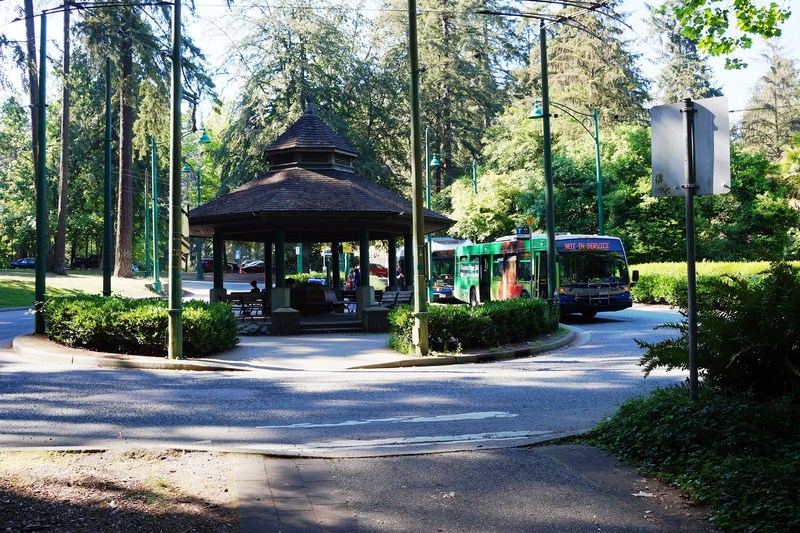
The Bus Loop located just up Pipeline Road from the traffic circle, next to the Miniature Train and Air Force Garden of Remembrance
How to Get There:There is a bus loop in Stanley Park and only one public bus (No. 19 Stanley Park) goes to the loop year round.

